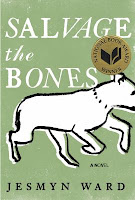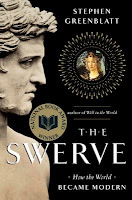Books to Get You Thinking
Each year in November the literary world awaits the results of the National Book Awards with eager anticipation and much speculation about likely winners. The awards are presented by the National Book Foundation for excellence in writing by US authors in the categories of fiction, nonfiction and poetry. Each category is judged by a separate panel of distinguished authors who have achieved literary excellence in their own respective genres. The 2011 winners include Jesmyn Ward for Salvage the Bones in the category of fiction, Stephen Greenblatt for The Swerve: How the World Became Modern in the nonfiction genre, and Nikky Finney for Head off &Split in the poetry category. Among the finalists are featured Andrew Krivak for his book, The Sojourn, Julie Otsuka for Buddha in the Attic, and Laura Redniss for her biography, Radioactive: Pierre and Marie Curie: Tale of Love and Fallout.
Fiction
Salvage the Bones by Jesmyn Ward Jesmyn Ward’s powerful book is cast against the backdrop of the gathering fury and clouds of Hurricane Katrina in a poverty stricken coastal town of Mississippi. Penned by an author who has lived through the trauma and devastation of the Hurricane, the book is striking in its use of magnificent imagery to portray young lives caught in the midst of stark poverty, desolation and hopelessness. Esch, a pregnant fourteen year old and her three brothers have no mother, just a father who is an alcoholic. Despite the harshness of the grim reality surrounding them, the siblings struggle to look out for each other in a heart wrenching story of survival and of the binding power of family and love.
The Sojourn by Andrew Krivak Inspired in large part by the author’s own personal family history, this gripping and intense novel revolves around its central character, Jozef Vinich and his journey from a small mining town in Colorado to the rural areas of Austria and Hungary where he grows up amongst the rugged mountains with his father and his cousin, Zlee. At the point where Vinich enlists as a sharpshooter in the Austro Hungarian army at the outbreak of World War I, Krivak’s writing transforms into a compelling account of the War, rich in historical detail , as he vividly brings to life the gruesome, harsh life in the trenches, the agonizing march across the frigid mountains, and the horrors of the Prisoners of War camps, all of which leaves an indelible mark on the reader, irrevocably dispelling any transient feelings of glory that might be associated with War.
The Buddha in the Attic by Julie Otsuka Using a unique lyrical style, the novel traces the extraordinary experiences of six young women who leave their homes in Japan in the early 1900s, anticipating a promising new life in America as new brides of Japanese American men living in San Francisco. Their dreams are shattered when they find the promised husbands bearing little resemblance to the photographs they had sent, nor employed in the lucrative trades they had described in their correspondence with their “picture brides” . Otsuka’s writing conveys a searing, poignant depiction of the grinding work of migrant labor, and the squalor and deep despair entwined in the lives of these women as they try to live and raise a family in the cultural divide of America, culminating in the internment of the Japanese American into camps during World War II.
Non Fiction
The Swerve: How the World Became Modern by Stephen Greenblatt Stephen Greenblatt has penned a unique literary work that holds a fascinating mix of History and Philosophy between its covers. The book centers around the discovery of an ancient Roman philosophical manuscript The Nature of Things by Lucretius that was based on the premise that the Universe functioned without the aid of Gods, that religious fear had a damaging effect on mankind and that all matter was made up of very small particles, set in eternal motion. Poggio Braccionlini, a book hunter, picked the book off a library shelf in 1417, arranged for it to be copied and it quickly became the underlying foundation for ideas and schools of thoughts associated with Galileo, Freud, Darwin, and Einstein, the Renaissance and the dawn of the modern World.
Radioactive: Pierre and Marie Curie: Tale of Love and Fallout by Lauren Redniss
A stunning juxtaposition of artwork and print is used skillfully by the author to write an insightful and gripping biography of the twice nominated Nobel Prize winning scientist, Marie Curie that reflects not just the story of her life in 19th century Paris as well as her unique personality but also elucidates her scientific achievements that proved to be the theoretical underpinnings for many modern inventions. The book is a result of extensive historical and scientific research that has included interviews with nuclear scientists, atom bomb survivors of Hiroshima and with Curie’s granddaughter. The use of a unique print media called cyanotype, along with the collection of photos, images, and line drawings make this a truly unique visual, scientific biography.
Poetry
Head Off & Split : Poems by Nikky Finney A Professor of creative writing at the University of Kentucky, author Nikky Finney has previously published three other highly acclaimed volumes of poetry: On Wings Made of Gauze, RICE and The World is Round. Born in the fifties in South Carolina, the daughter of educators and activists, Nikky Finny was a witness to the years of segregation and significant landmark events in American History. She has made an important contribution to African American literature and her newest volume is a breathtakingly impassioned and deeply stirring collection of poems that touch on varied themes from the defiance of Rosa Parks, to the despair of a woman stranded on a rooftop during Hurricane Katrina.
Fiction
Salvage the Bones by Jesmyn Ward Jesmyn Ward’s powerful book is cast against the backdrop of the gathering fury and clouds of Hurricane Katrina in a poverty stricken coastal town of Mississippi. Penned by an author who has lived through the trauma and devastation of the Hurricane, the book is striking in its use of magnificent imagery to portray young lives caught in the midst of stark poverty, desolation and hopelessness. Esch, a pregnant fourteen year old and her three brothers have no mother, just a father who is an alcoholic. Despite the harshness of the grim reality surrounding them, the siblings struggle to look out for each other in a heart wrenching story of survival and of the binding power of family and love.
The Sojourn by Andrew Krivak Inspired in large part by the author’s own personal family history, this gripping and intense novel revolves around its central character, Jozef Vinich and his journey from a small mining town in Colorado to the rural areas of Austria and Hungary where he grows up amongst the rugged mountains with his father and his cousin, Zlee. At the point where Vinich enlists as a sharpshooter in the Austro Hungarian army at the outbreak of World War I, Krivak’s writing transforms into a compelling account of the War, rich in historical detail , as he vividly brings to life the gruesome, harsh life in the trenches, the agonizing march across the frigid mountains, and the horrors of the Prisoners of War camps, all of which leaves an indelible mark on the reader, irrevocably dispelling any transient feelings of glory that might be associated with War.
The Buddha in the Attic by Julie Otsuka Using a unique lyrical style, the novel traces the extraordinary experiences of six young women who leave their homes in Japan in the early 1900s, anticipating a promising new life in America as new brides of Japanese American men living in San Francisco. Their dreams are shattered when they find the promised husbands bearing little resemblance to the photographs they had sent, nor employed in the lucrative trades they had described in their correspondence with their “picture brides” . Otsuka’s writing conveys a searing, poignant depiction of the grinding work of migrant labor, and the squalor and deep despair entwined in the lives of these women as they try to live and raise a family in the cultural divide of America, culminating in the internment of the Japanese American into camps during World War II.
Non Fiction
The Swerve: How the World Became Modern by Stephen Greenblatt Stephen Greenblatt has penned a unique literary work that holds a fascinating mix of History and Philosophy between its covers. The book centers around the discovery of an ancient Roman philosophical manuscript The Nature of Things by Lucretius that was based on the premise that the Universe functioned without the aid of Gods, that religious fear had a damaging effect on mankind and that all matter was made up of very small particles, set in eternal motion. Poggio Braccionlini, a book hunter, picked the book off a library shelf in 1417, arranged for it to be copied and it quickly became the underlying foundation for ideas and schools of thoughts associated with Galileo, Freud, Darwin, and Einstein, the Renaissance and the dawn of the modern World.
Radioactive: Pierre and Marie Curie: Tale of Love and Fallout by Lauren Redniss
A stunning juxtaposition of artwork and print is used skillfully by the author to write an insightful and gripping biography of the twice nominated Nobel Prize winning scientist, Marie Curie that reflects not just the story of her life in 19th century Paris as well as her unique personality but also elucidates her scientific achievements that proved to be the theoretical underpinnings for many modern inventions. The book is a result of extensive historical and scientific research that has included interviews with nuclear scientists, atom bomb survivors of Hiroshima and with Curie’s granddaughter. The use of a unique print media called cyanotype, along with the collection of photos, images, and line drawings make this a truly unique visual, scientific biography.
Poetry
Head Off & Split : Poems by Nikky Finney A Professor of creative writing at the University of Kentucky, author Nikky Finney has previously published three other highly acclaimed volumes of poetry: On Wings Made of Gauze, RICE and The World is Round. Born in the fifties in South Carolina, the daughter of educators and activists, Nikky Finny was a witness to the years of segregation and significant landmark events in American History. She has made an important contribution to African American literature and her newest volume is a breathtakingly impassioned and deeply stirring collection of poems that touch on varied themes from the defiance of Rosa Parks, to the despair of a woman stranded on a rooftop during Hurricane Katrina.
-Nita Mathur






Comments
Post a Comment